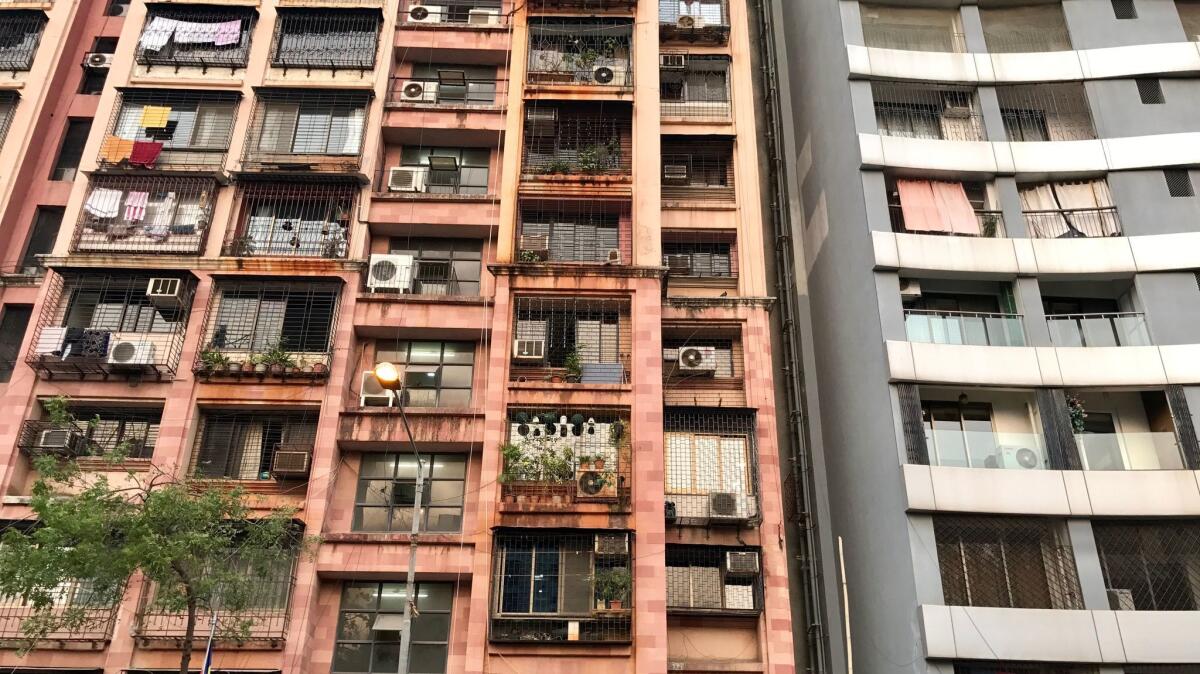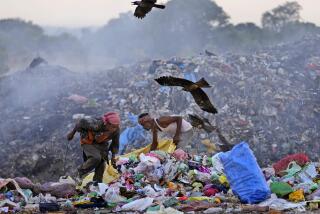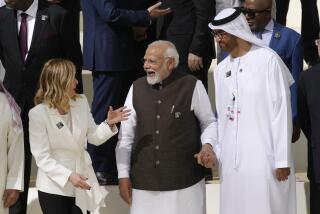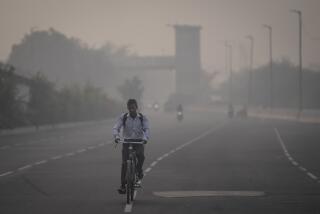One appliance could determine whether India, and the world, meet climate change targets

- Share via
Reporting from MUMBAI, India — Raheel Shaikh had worked his way up from a $90-a-month entry-level job in digital marketing to a position that paid 10 times as much. He remodeled the two-room apartment he shares with his parents, bought a motorbike and was planning his wedding in January.
Finally, this summer, the 30-year-old Shaikh splurged on the new must-have item for the upwardly mobile Indian: an air conditioner.
On a warm afternoon in November, Shaikh sat inside his living room and explained how the $800 Japanese appliance quietly exhaling overhead had made it easier for his parents to sleep in the deadening tropical heat of Mumbai, India’s commercial capital, and bearable to work on his laptop late into the night. It had also pleased his fiancee to know she would move into an air-conditioned home.
POWERING INDIA: Inside India’s epic effort to bring electricity to millions »
“My parents lived without it all their lives, but I am earning well so I wanted to give them that comfort,” Shaikh said. “For a middle-class Indian like me, it was part of my plan.”
More than any other household good, the air conditioner symbolizes the soaring aspirations of one of the world’s fastest-growing major economies. Although only 5% of Indians own the appliances today, they are buying millions more every year, driving a worldwide boom that, according to one estimate, will nearly triple the planet’s stock of air conditioners to 2.5 billion by 2050.
When Shaikh was growing up, air conditioning was a luxury associated with five-star hotels, while ordinary Indians survived the summers by lugging pedestal fans from room to room or dabbing themselves with wet towels. As temperatures and incomes rise, the air conditioner is now what Nikit Abhyankar, a researcher at the Lawrence Berkeley National Laboratory calls “a threshold good — the moment you cross into that middle-class income level, you go and buy one.”
But all that crisp air will carry mammoth challenges.
The average air conditioner sucks 20 times as much energy as a ceiling fan, and studies show that space cooling accounts for 40% to 60% of the peak energy load during the summer in hot Indian cities such as Mumbai and New Delhi. By 2030, Abhyankar projects, the explosion in air conditioning alone will raise India’s electricity demands by 150 gigawatts, the equivalent of adding three economies the size of California to its power grid.
Most of that electricity will come from coal, pumping out more of the carbon emissions that are blamed for worsening pollution, respiratory diseases, millions of premature deaths and hotter air temperatures — which will only push people to buy more air conditioners.
India is in the midst of one of the biggest urban transitions in history, with more than 400 million people projected to migrate to cities by 2050. How it meets the energy needs of its growing urban middle class — and the village dwellers it’s connecting to electricity for the first time — will determine whether it fulfills its pledges to shift away from heavily polluting fossil fuels and contribute to the global fight against climate change.
“Meeting such rapidly rising demand in a cost-effective, sustainable and equitable manner is the biggest challenge,” Abhyankar said.
“And this is from just one appliance. There are multiple appliances that Indians will add as incomes rise. So it is really a make-or-break moment.”
China faced a similar moment in the last decade of the 20th century. Over 15 years, urban Chinese plugged in more than 200 million new room air conditioners, adding 200 to 250 gigawatts of peak electricity demand — most of which was met by carbon-belching thermal power plants. Those emissions trap heat in the atmosphere, warming the planet.
As U.S. retreats on climate goals, China launches the world’s biggest carbon trading market »
India has pledged to grow more efficiently by expanding its use of renewable energy sources and, under the Paris climate agreement, committed to slash the carbon emissions it creates per unit of economic activity. As the price of solar power has plunged, Prime Minister Narendra Modi has boasted of creating some of the world’s biggest solar parks.
But to lift hundreds of millions of people out of poverty requires readily available electricity, and Indian officials say that means coal will remain the country’s most important fuel source for the foreseeable future.
“The reality of India’s energy sector is that around three-quarters of our power comes from coal-powered plants and this scenario will not change significantly over the coming decades,” NITI Aayog, the government’s main policy planning think tank, said in an August report in which it spelled out a nine-point plan to increase coal production.
India’s aging coal infrastructure is notoriously noxious. The Center for Science and Environment, a New Delhi-based independent research group, studied the country’s industrial sector and found that power plants produce 60% of the particulate matter that hangs in the air and clogs lungs.
Pollution from coal-fired thermal plants was one cause of the thick smog that enveloped New Delhi in November and caused car pile-ups and school closures. But despite a growing public outcry, coal plants failed to meet a December 2017 deadline to achieve modest reductions in emissions.

The link between prosperity and a hotter, smoggier planet is not often appreciated by India’s newly minted middle class.
In Mumbai, a sliver of land jutting into the Arabian Sea, coastal breezes and mangrove forests once kept the summers mild. But pell-mell development has swallowed the city’s tree cover as its population has ballooned to more than 18 million — accelerating what scientists call the “heat island” effect, where dry, exposed surfaces like roads and rooftops bake in the sun and radiate even more warmth into the air.
Across South Asia, whose tropical zones include some of the world’s largest cities, extreme heat waves are becoming more common and deadly, making air conditioners lifesaving pieces of technology. In 2009, a study by Michael Sivak of the University of Michigan estimated that the potential demand for cooling in Mumbai alone was one-quarter that of the entire United States, which has 18 times the population.
“The climate was much better in my childhood,” said Shaikh, who grew up with three sisters on a hilltop that was once covered in trees. Even if they could have afforded one, they never needed an air conditioner, he said.
Now the neighborhood is full of families who have gradually replaced mud walls with concrete and affixed satellite dishes to their roofs. The cage-like compressors of split air-conditioning units poke from the sides of several houses.
“With the real-estate boom in Mumbai, so much greenery has been cut,” Shaikh said. “You see how the temperatures are now. It’s possible we’ll have to use the AC even in the winter.”
India has taken steps to introduce more energy-efficient appliances to the market, and it joined 197 countries last year in agreeing to phase out hydrofluorocarbons — a family of heat-trapping greenhouse gases used in air conditioners and refrigerants — by the late 2040s. The cost of buying and running air conditioners has plunged; Shaikh’s premium unit raised his monthly power bill by only 25% over the summer, he said.
But many old, power-guzzling models live on, refurbished by secondhand dealers and sold for a fraction of the cost of new ones. India heavily subsidizes electricity bills, offering most consumers little incentive to spend on more efficient products.
An hour east of New Delhi in the industrial city of Ghaziabad, where cargo trucks and taxis inch along a clogged highway and boxy apartment blocks rise from former pastureland, 23-year-old Manish Nagar operates a small repair shop decorated with pictures of appliances.
Over the summer, when temperatures touched 115 degrees, Nagar got roughly 30 calls a day to fix air conditioners — most from clients who own noisy old window units kept alive by his team of a dozen repairmen.
“The working class can’t afford a $500 AC, but they can get some comfort with a $200 one,” Nagar said. “There are so many people living here and commuting to jobs in Delhi. Villagers see the progress in the city and they want to bring a little bit of that progress into their homes.”

A short drive away in his neighborhood of weathered two-story houses, Nagar ticked off the names of neighbors who had bought coolers from him. Business was so good that he finally installed one this year in the house he shares with his parents and three younger brothers.
The year-old model, which a customer resold to him for about $150, was far from the most efficient on the market, Nagar said. But it did not matter, because his family — like 80% of the 35 million households in Uttar Pradesh state — doesn’t have an electricity meter installed and instead pays a fixed price for a black-market connection.
His mother, Usha, did not like the window unit, made by the Indian manufacturer Voltas. She thought the gusts of cool air made her sick.
“But I’m happy we have one,” she said on the concrete porch, fanning herself with one end of her patterned scarf. She hoped Nagar would soon be married, she added, and his future wife would appreciate it.
“The AC is not an option anymore,” Nagar said. “It is a way of life.”
This story was reported with a grant from the United Nations Foundation.
Follow @SBengali on Twitter for more news from South Asia
More to Read
Sign up for Essential California
The most important California stories and recommendations in your inbox every morning.
You may occasionally receive promotional content from the Los Angeles Times.











